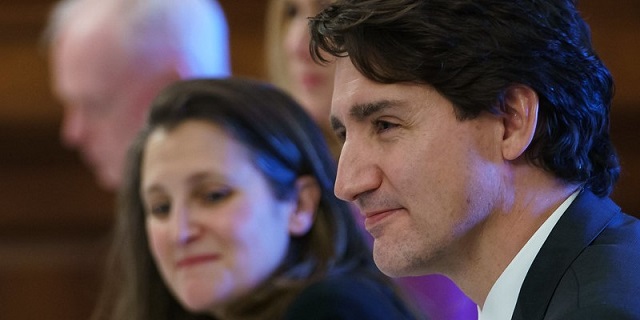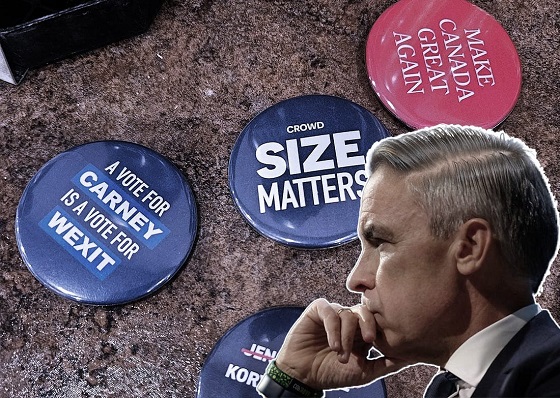Frontier Centre for Public Policy
Canada’s Leadership Vacuum Fueling a National Crisis

From the Frontier Centre for Public Policy
By David Leis
Canada is at a breaking point. Weak border security, unchecked organized crime, and rampant foreign interference have left the country dangerously exposed to threats that jeopardize its safety, economy, and sovereignty. Under Prime Minister Justin Trudeau’s leadership, these challenges have escalated to unprecedented levels, and no meaningful action has been taken to address them.
In British Columbia, a mother of two recently shared how the fentanyl crisis has ravaged her community. She spoke of losing friends and neighbours to overdoses, while her own family lives in fear of growing gang activity. Her story illustrates the human cost of systemic inaction and highlights the devastating consequences of a government unable to protect its people. It is a tragic reality mirrored in communities across the country, from urban centres to small towns, where drugs and crime are taking a growing toll.
Canada’s border management, a critical first line of defence, is failing to stem the tide of illicit goods and activities. The Canada Border Services Agency inspects less than two per cent of shipping containers entering the country, leaving ports like Vancouver vulnerable to transnational crime. According to the Cullen Commission, billions of dollars are laundered annually in British Columbia, often through casinos and real estate linked to organized crime. Transparency International’s 2022 report ranked Canada among the worst in the G7 for anti-money laundering enforcement, underlining systemic failures.
Weak border controls are exacerbating the fentanyl crisis. Precursor chemicals flow into Canada largely unchecked, often disguised as legitimate imports. Provincial officials in British Columbia have acknowledged the need for tighter regulations on pill presses, but federal laws remain inconsistent. The consequences are staggering: over 34,000 Canadians have died of opioid overdoses since 2016, according to Health Canada. These are not just numbers; they represent families shattered and communities in mourning. Yet, the federal government continues to respond with piecemeal measures instead of a comprehensive national strategy.
Concerns over foreign interference add another dimension to Canada’s vulnerability. Weak borders and lax enforcement also provide fertile ground for foreign actors to exploit. The recent inquiry into election interference revealed disturbing levels of meddling, with CSIS identifying instances of Chinese state funding for federal candidates. Hybrid warfare tactics – including cyberattacks, economic manipulation, and political interference – are well-documented. These activities undermine Canada’s sovereignty and erode trust in its democratic institutions.
International partners, particularly the United States, are taking notice. Canada’s largest trading partner has grown increasingly frustrated with these vulnerabilities. Under a potential Trump administration, Canada could face severe economic repercussions, including tariffs, if it does not address its security deficiencies. A report from the Global Initiative Against Transnational Organized Crime labelled Canada a “safe zone” for transnational crime, citing weak enforcement and limited co-ordination among intelligence agencies. Such critiques directly challenge Canada’s reputation and its role as a trusted ally.
Canada’s aging infrastructure compounds these security failures. A 2023 report from Statistics Canada revealed that nearly 40 per cent of the country’s infrastructure is nearing the end of its useful life. Ports, highways, and public utilities – critical for trade and national security – are underfunded and rapidly deteriorating. This hampers economic competitiveness and leaves Canada ill prepared to secure its supply chains. These failings highlight a broader issue: the government’s reluctance to prioritize foundational investments that ensure long-term stability.
Meanwhile, Canada’s regulatory framework struggles to keep pace with modern threats. The country lacks effective oversight to combat money laundering, cyberattacks, and supply chain exploitation. Organized crime and illicit trade drain billions from the economy every year. Weak border controls have made Canada a transit point for everything from drugs to counterfeit goods. Provincial attempts at regulation, like in British Columbia, have helped somewhat, but federal legislation has yet to catch up.
Canada’s challenges didn’t emerge overnight. They are the result of decades of underinvestment in security, weak enforcement, and a lack of political will. While the Trudeau government has failed to address these issues, previous administrations are responsible for creating the conditions that allowed them to fester.
However, the current government bears responsibility for the lack of urgency in the face of escalating crises. Performative policies, like token GST rebates, do little to address systemic issues. The Trudeau government has failed to modernize Canada’s security apparatus, prioritizing political optics over substantive reform.
Canada cannot afford to remain passive in the face of these mounting threats. The government must decisively modernize border security, combat organized crime, and confront foreign interference with meaningful legislation and enforcement. Countries like Australia have successfully implemented advanced port screening and stricter anti-money laundering laws to address similar issues. Canada must follow suit to regain control of its borders and restore trust in its institutions.
The stakes couldn’t be higher. Every uninspected container ship, every fentanyl overdose, and every election left vulnerable to interference represents a failure of leadership. The mother in B.C., fearing for her children’s future, is not alone – she represents countless Canadians who feel abandoned by a government unwilling to act. Her voice, and others like hers, demand attention.
This is no longer about politics or optics; it’s about safeguarding the nation’s future. The time for complacency has passed. Canada’s security, prosperity, and sovereignty depend on immediate, decisive leadership.
Anything less is unacceptable.
David Leis is President and CEO of the Frontier Centre for Public Policy and host of the Leaders on the Frontier podcast.
Energy
Federal Clean Power Plan Risks Blackouts And Higher Bills

From the Frontier Centre for Public Policy
Ottawa’s Clean Electricity Regulations could derail Canada’s energy future. Here’s what we need to do
The federal government’s push to make Canada’s electricity system net-zero is running straight into reality—and it’s not pretty.
Through the Clean Electricity Regulations (CER), the government wants all provinces to eliminate greenhouse gas emissions from electricity generation by 2035. It is an ambitious goal, but one that ignores a basic fact: demand for electricity is exploding, and provinces are struggling to keep up.
New technologies like artificial intelligence are supercharging this demand. AI systems, including tools such as ChatGPT, rely on massive data centres—huge warehouses of computer servers that need constant cooling and enormous amounts of electricity to function. According to a recent Royal Bank of Canada report, if all proposed data centre projects in Canada move ahead, they would consume 14 per cent of the country’s entire electricity supply by 2030. That is roughly the same as projections in the United States, where data centres are expected to use up to 15 per cent of the national total.
This is a serious problem. Provinces such as Alberta and Saskatchewan have already raised the alarm, arguing that the federal regulations overstep Ottawa’s constitutional authority. Energy supply, like natural resources, has traditionally been under provincial control. Alberta and Ontario operate their own electricity markets to attract investment and ensure reliability. Federal regulations threaten to undermine these efforts, adding risk and driving up costs.
The situation is already tense. Alberta, for example, issued multiple grid alerts in 2024 due to shortages and market disruptions. The province is now looking at “behind-the-fence” power solutions, encouraging data centres to generate their own electricity to guarantee stability.
Canada was not always in this bind. For decades, we enjoyed an abundance of clean, affordable hydroelectric power. Provinces like Quebec, British Columbia, Manitoba and Newfoundland and Labrador built massive hydro projects starting in the 1960s, creating cheap power and even surpluses to export to U.S. markets. In 2022, for example, B.C. sent 74 per cent of its exported power to the U.S., while Quebec sent 63 per cent and Ontario an impressive 81 per cent, generating billions in revenue.
But that era is coming to an end. Most of the best sites for hydro dams have already been developed. New projects would require expensive, long-distance transmission lines to bring power from remote areas to the cities that need it. On top of that, growing environmental concerns make new dam construction an uphill battle.
The truth is, there is no quick fix. A 2025 study by the Fraser Institute paints a grim picture: to meet future electricity demand solely with solar power would require 1,680 years of construction. Wind power? About 1,150 years. Even hydro would take close to a millennium. Even if we combined these sources, we are still looking at more than 1,000 years to build enough capacity.
Meanwhile, federal projections estimate that Canada’s electricity demand will double by 2050.
Without significant policy changes, Canadians could soon face the worst of both worlds: soaring electricity bills and the threat of power shortages. Our economy could also suffer as companies and data centres look to other jurisdictions with more reliable power supplies.
So what should Canada do? Here are three practical steps:
- Scrap the Clean Electricity Regulations. Provinces like Alberta and Saskatchewan are already committed to reaching net-zero by 2050. Federal interference only creates unnecessary political battles and delays investments.
- Fast-track approvals for new interprovincial transmission lines. Today, building a new transmission line can take more than a decade. Speeding up this process would help provinces share power and avoid costly overbuilding of generation capacity.
- Launch a major low-interest loan program to build new power infrastructure. We need to dramatically expand our generation and transmission systems, including natural gas-fired plants, to meet future demand.
Canadians deserve a reliable, affordable and clean energy future. But we will not get there by ignoring the realities of rising demand and provincial responsibilities. It is time for the federal government to listen to the provinces, embrace practical solutions and avoid an avoidable crisis.
Otherwise, we are on track for blackouts, higher bills and missed economic opportunities.
Maureen McCall is an energy business analyst and Fellow at the Frontier Center for Public Policy. She writes on energy issues for EnergyNow and the BOE Report. She has 20 years of experience as a business analyst for national and international energy companies in Canada.
Economy
The Net-Zero Dream Is Unravelling And The Consequences Are Global

From the Frontier Centre for Public Policy
The grand net-zero vision is fading as financial giants withdraw from global climate alliances
In recent years, governments and Financial institutions worldwide have committed to the goal of “net zero”—cutting greenhouse gas emissions to as close to zero as possible by 2050. One of the most prominent initiatives, the Glasgow Financial Alliance for Net Zero (GFANZ), sought to mobilize trillions of dollars by shifting investment away from fossil fuels and toward green energy projects.
The idea was simple in principle: make climate action a core part of financial decision-making worldwide.
The vision of a net-zero future, once championed as an inevitable path to global prosperity and environmental sustainability, is faltering. What began as an ambitious effort to embed climate goals into the flow of international capital is now encountering hard economic and political realities.
By redefining financial risk to include climate considerations, GFANZ aimed to steer financial institutions toward supporting a large-scale energy transition.
Banks and investors were encouraged to treat climate-related risks—such as the future decline of fossil fuels—as central to their financial strategies.
But the practical challenges of this approach have become increasingly clear.
Many of the green energy projects promoted under the net-zero banner have proven financially precarious without substantial government subsidies. Wind and solar technologies often rely on public funding and incentives to stay competitive. Energy storage and infrastructure upgrades, critical to supporting renewable energy, have also required massive financial support from taxpayers.
At the same time, institutions that initially embraced net-zero commitments are now facing soaring compliance costs, legal uncertainties and growing political resistance, particularly in major economies.
Major banks such as JPMorgan Chase, Citigroup and Goldman Sachs have withdrawn from GFANZ, citing concerns over operational risks and conflicting fuduciary duties. Their departure marks a signifcant blow to the alliance and signals a broader reassessment of climate finance strategies.
For many institutions, the initial hope that governments and markets would align smoothly around net-zero targets has given way to concerns over financial instability and competitive disadvantage. But that optimism has faded.
What once appeared to be a globally co-ordinated movement is fracturing. The early momentum behind net-zero policies was fuelled by optimism that government incentives and public support would ease the transition. But as energy prices climb and affordability concerns grow, public opinion has become noticeably more cautious.
Consumers facing higher heating bills and fuel costs are beginning to question the personal price of aggressive climate action.
Voters are increasingly asking whether these policies are delivering tangible benefits to their daily lives. They see rising costs in transportation, food production and home energy use and are wondering whether the promised green transition is worth the economic strain.
This moment of reckoning offers a crucial lesson: while environmental goals remain important, they must be pursued in balance with economic realities and the need for reliable energy supplies. A durable transition requires market-based solutions, technological innovation and policies that respect the complex needs of modern economies.
Climate progress will not succeed if it comes at the expense of basic affordability and economic stability.
Rather than abandoning climate objectives altogether, many countries and industries are recalibrating, moving away from rigid frameworks in favour of more pragmatic, adaptable strategies. Flexibility is becoming essential as governments seek to maintain public support while still advancing long term environmental goals.
The unwinding of GFANZ underscores the risks of over-centralized approaches to climate policy. Ambitious global visions must be grounded in reality, or they risk becoming liabilities rather than solutions. Co-ordinated international action remains important, but it must leave room for local realities and diverse economic circumstances.
As the world adjusts course, Canada and other energy-producing nations face a clear choice: continue down an economically restrictive path or embrace a balanced strategy that safeguards both prosperity and environmental stewardship. For countries like Canada, where natural resources remain a cornerstone of the economy, the stakes could not be higher.
The collapse of the net-zero consensus is not an end to climate action, but it is a wake-up call. The future will belong to those who learn from this moment and pursue practical, sustainable paths forward. A balanced approach that integrates environmental responsibility with economic pragmatism offers the best hope for lasting progress.
Marco Navarro-Genie is the vice president of research at the Frontier Centre for Public Policy. With Barry Cooper, he is coauthor of Canada’s COVID: The Story of a Pandemic Moral Panic (2023).
-

 COVID-192 days ago
COVID-192 days agoThe Pandemic Justice Phase Begins as Criminal Investigations Commence
-

 Autism2 days ago
Autism2 days agoRFK Jr. Completely Shatters the Media’s Favorite Lie About Autism
-

 Economy1 day ago
Economy1 day agoThe Net-Zero Dream Is Unravelling And The Consequences Are Global
-

 Energy1 day ago
Energy1 day agoFederal Clean Power Plan Risks Blackouts And Higher Bills
-

 2025 Federal Election1 day ago
2025 Federal Election1 day agoHomebuilding in Canada stalls despite population explosion
-

 Alberta1 day ago
Alberta1 day agoCPP another example of Albertans’ outsized contribution to Canada
-

 Energy2 days ago
Energy2 days ago‘War On Coal Is Finally Over’: Energy Experts Say Trump Admin’s Deregulation Agenda Could Fuel Coal’s ‘Revival’
-

 2025 Federal Election2 days ago
2025 Federal Election2 days agoThe “Hardhat Vote” Has Embraced Pierre Poilievre








